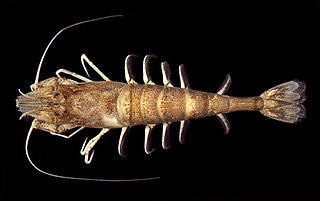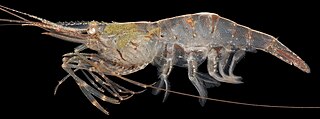
The Caridea, commonly known as caridean shrimp or true shrimp, are an infraorder of shrimp within the order Decapoda. This infraorder contains all species of true shrimp. They are found widely around the world in both fresh and salt water. Many other animals with similar names – such as the mud shrimp of Axiidea and the boxer shrimp of Stenopodidea – are not true shrimp, but many have evolved features similar to true shrimp.

Dendrobranchiata is a suborder of decapods, commonly known as prawns. There are 540 extant species in seven families, and a fossil record extending back to the Devonian. They differ from related animals, such as Caridea and Stenopodidea, by the branching form of the gills and by the fact that they do not brood their eggs, but release them directly into the water. They may reach a length of over 330 millimetres (13 in) and a mass of 450 grams (1.0 lb), and are widely fished and farmed for human consumption.

The Decapoda or decapods are an order of crustaceans within the class Malacostraca, including many familiar groups, such as crabs, lobsters, crayfish, shrimp and prawns. Most decapods are scavengers. The order is estimated to contain nearly 15,000 species in around 2,700 genera, with around 3,300 fossil species. Nearly half of these species are crabs, with the shrimp and Anomura including hermit crabs, porcelain crabs, squat lobsters making up the bulk of the remainder. The earliest fossil decapod is the Devonian Palaeopalaemon.

Tabgha is an area situated on the north-western shore of the Sea of Galilee in Israel and a depopulated Palestinian village. It is traditionally accepted as the place of the miracle of the multiplication of the loaves and fishes and the fourth resurrection appearance of Jesus after his Crucifixion. The village population was expelled in 1948 during Operation Broom.

The Stenopodidea or boxer shrimps are a small group of decapod crustaceans. Often confused with Caridea shrimp or Dendrobranchiata prawns, they are neither, belonging to their own group.

Eucarida is a superorder of the Malacostraca, a class of the crustacean subphylum, comprising the decapods, krill, Amphionides and Angustidontida. They are characterised by having the carapace fused to all thoracic segments, and by the possession of stalked eyes.

Typhlocaris is a genus of blind cave-dwelling shrimp, placed in its own family, Typhlocarididae. It contains 4 species:
Physetocaris is a monotypic genus of caridean shrimp, containing a single species, Physetocaris microphthalma.
Cryphiops caementarius is a South American freshwater shrimp.

Troglocaris is a genus of freshwater shrimp in the family Atyidae. These stygobitic, whitish and eyeless shrimp are found in Southern Europe. Although locally very common, the small ranges of the individual species make them highly vulnerable to habitat loss, for example by water extraction. Their underground habitat is often extremely stable; for example, the Vipavska jama cave in Slovenia is home to a population of T. anophthalmus, and its water only varies from 10 °C (50 °F) in the winter to 11 °C (52 °F) in the summer. In some Dinaric caves, notably Vjetrenica, as many as three species may occur together.

Palaemon serratus, also called the common prawn, is a species of shrimp found in the Atlantic Ocean from Denmark to Mauritania, and in the Mediterranean Sea and Black Sea.

Stygiocaris is a genus of shrimp from caves in the North West Cape and Barrow Island, Western Australia.

Heterocarpus is a genus of deep-sea shrimp, mainly of tropical areas all over the world.
Birulia is a genus of shrimp. It is one of a group of genera that are usually treated as part of the family Hippolytidae, but have also been separated off as the family Thoridae.

Crangon septemspinosa is a species of shrimp, one of several known as the sand shrimp. It lives along the Atlantic coast of North America, from Newfoundland to Florida, at depths to 450 m (1,480 ft).

Typhlocaris ayyaloni is a species of troglobitic shrimp in the family Typhlocarididae.

Palaemon pandaliformis is a species of shrimp of the family Palaemonidae. It is found along with Palaemon northropi.

Palaemon macrodactylus is a species of shrimp of the family Palaemonidae.
Macrobrachium indicum is a species of freshwater shrimp of South India. It was first described in 1986. This freshwater prawn was described from Vellayani Lake, Kerala. This species is closely related to M. australe and M. ustulatum. It is a medium-sized prawn of genus Macrobrachium.














